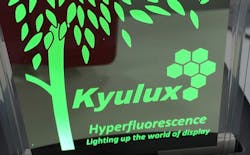Kyulux licenses Harvard intelligence system to identify OLED material candidates
Organic light-emitting diode (OLED) materials startup company Kyulux (Fukuoka, Japan), focused on next-generation OLED lighting technology known as TADF (thermally activated delayed fluorescence), secured a license to Harvard University's Molecular Space Shuttle deep learning system for the discovery of materials for display and lighting applications. The Molecular Space Shuttle is an artificial intelligence platform designed by Alán Aspuru-Guzik's group at Harvard's Department of Chemistry and Chemical Biology.
RELATED ARTICLE: Color OLED/reflective LCD hybrid display can be easily seen in full sunlight
In a Nature Materials publication, Aspuru-Guzik and his group demonstrated the ability of the system to rapidly screen millions of molecules for stability and other characteristics necessary for a molecule to produce light with the characteristics necessary for use in commercial production of cell phone and television displays.
"By developing a sophisticated molecular builder, using state-of-the-art quantum chemistry and machine learning, in addition to drawing on the expertise of experimentalists, we discovered a large set of high-performing blue OLED materials," said Aspuru-Guzik, professor of Chemistry and Chemical Biology, who led the research. "Following that validation, I am extremely excited to see this platform adopted for commercial development, utilizing its capabilities for the rapid screening of TADF materials."
The license agreement coordinated by Harvard's Office of Technology Development provides Kyulux with rights to the copyrighted software. The algorithms dramatically reduce the computational cost of testing candidate molecules for new technologies.
"We were able to model these molecules in a way that was really predictive," said Rafael Gómez-Bombarelli, a postdoctoral fellow in the Aspuru-Guzik lab and first author of the paper. "We could predict the color and the brightness of the molecules from a simple quantum chemical calculation and about 12 hours of computing per molecule."
"TADF molecules require very complicated material design rules to achieve highly efficient emission and long lifetimes for commercialization. The Molecular Space Shuttle enables us to access a wide variety of molecules which we have not designed yet within a short period. This is a key technology for enhancing the competitiveness of Kyulux," said Junji Adachi, CTO of Kyulux.
Three of the Harvard-trained researchers will be joining Kyulux's North America Office, which is opening this month in the Downtown Boston area to carry out computational discovery and experimental synthesis and characterization.
SOURCE: Kyulux; www.kyulux.com

Gail Overton | Senior Editor (2004-2020)
Gail has more than 30 years of engineering, marketing, product management, and editorial experience in the photonics and optical communications industry. Before joining the staff at Laser Focus World in 2004, she held many product management and product marketing roles in the fiber-optics industry, most notably at Hughes (El Segundo, CA), GTE Labs (Waltham, MA), Corning (Corning, NY), Photon Kinetics (Beaverton, OR), and Newport Corporation (Irvine, CA). During her marketing career, Gail published articles in WDM Solutions and Sensors magazine and traveled internationally to conduct product and sales training. Gail received her BS degree in physics, with an emphasis in optics, from San Diego State University in San Diego, CA in May 1986.
